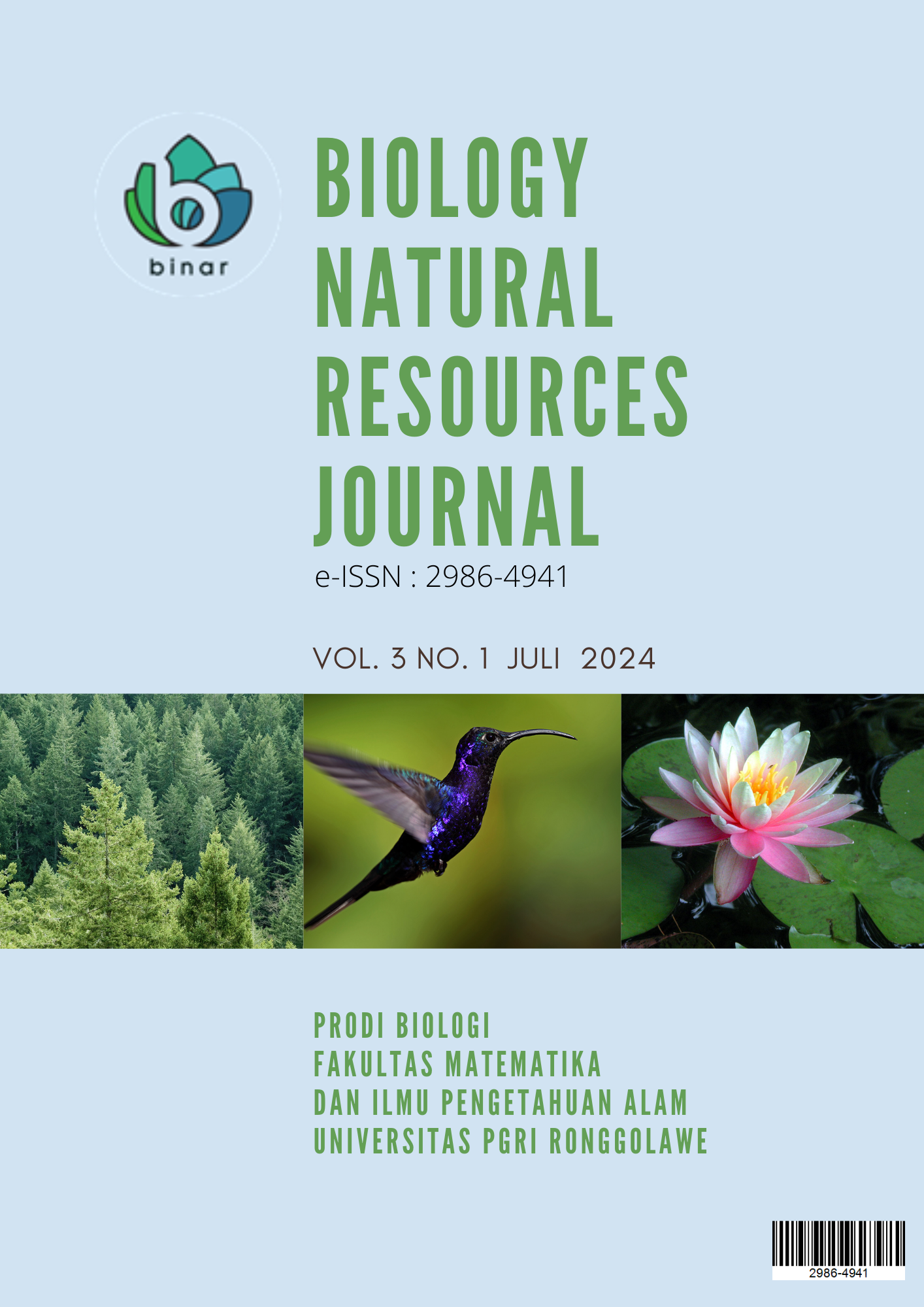PREFERENSI HABITAT LABA-LABA DI KAWASAN KARST SUAKA MARGASATWA PALIYAN
DOI:
https://doi.org/10.55719/binar.v3i2.1360Keywords:
keanekaragaman, laba-laba, Araneae, Suaka MargasatwaAbstract
Abstrak. Indonesia, yang terkenal dengan keanekaragaman hayatinya yang tinggi, masih belum banyak dieksplorasi dalam hal takson invertebrata seperti laba-laba. Penelitian ini bertujuan untuk mengidentifikasi spesies laba-laba di Suaka Margasatwa Paliyan, sebuah kawasan hutan lindung di Gunungkidul dalam ekosistem karst Gunung Sewu. Penelitian dilakukan dari 8-31 Oktober 2022, menggunakan survei eksplorasi dan dokumentasi morfologi, serta identifikasi di laboratorium Kalamangga. Hasil penelitian menunjukkan 92 spesies laba-laba dari 25 famili, dengan distribusi yang bervariasi di makrohabitat seperti gua, hutan, kebun, rumput, dan pemukiman. Temuan ini menyoroti adaptasi ekologis laba-laba dan pengaruh makrohabitat terhadap distribusinya, memberikan wawasan penting untuk konservasi dan pengelolaan habitat.
Downloads
References
World Spider Catalog, “World Spider Catalog.” Accessed: Jul. 17, 2024. [Online]. Available: https://wsc.nmbe.ch/
D. E. Ramos Gutierrez, “Diversity and Trophic Ecology of Arboreal Spider (Araneae) Assemblages along a Transformation Gradient from Lowland Rainforest to Oil Palm Plantations in Jambi Province, Sumatra, Indonesia,” 2023.
M. Nyffeler and K. Birkhofer, “An estimated 400–800 million tons of prey are annually killed by the global spider community,” Sci. Nat., vol. 104, no. 3, pp. 1–12, 2017.
C. L. Deeleman-Reinhold, “Family Liocranidae,” in Forest Spiders of South East Asia, Brill, 2001, pp. 399–505.
J. D. Harwood, K. D. Sunderland, and W. O. C. Symondson, “Prey selection by linyphiid spiders: molecular tracking of the effects of alternative prey on rates of aphid consumption in the field,” Mol. Ecol., vol. 13, no. 11, pp. 3549–3560, 2004.
J. Vasconcellos-Neto, Y. F. Messas, H. da Silva Souza, G. A. Villanueva-Bonila, and G. Q. Romero, “Spider–plant interactions: an ecological approach,” Behav. Ecol. spiders Contrib. from Neotrop. Reg., pp. 165–214, 2017.
S. J. Blamires, M. B. Thompson, and D. F. Hochuli, “Habitat selection and web plasticity by the orb spider Argiope keyserlingi (Argiopidae): do they compromise foraging success for predator avoidance?,” Austral Ecol., vol. 32, no. 5, pp. 551–563, 2007.
G. W. Uetz, “Habitat structure and spider foraging,” Habitat Struct. Phys. Arrange. objects Sp., pp. 325–348, 1991.
S. C. Voss, B. Y. Main, and I. R. Dadour, “Habitat preferences of the urban wall spider Oecobius navus (Araneae, Oecobiidae),” Aust. J. Entomol., vol. 46, no. 4, pp. 261–268, 2007.
R. Michalko and K. Birkhofer, “Habitat niches suggest that non-crop habitat types differ in quality as source habitats for Central European agrobiont spiders,” Agric. Ecosyst. Environ., vol. 308, p. 107248, 2021.
S. M. Cobbold and S. R. Supp, “Patch shape alters spider community structure: links between microhabitat choice and sensitivity to increased edge habitat,” J. Insect Conserv., vol. 16, pp. 581–589, 2012.
N. Glover, “The habitat preferences of web building spiders,” 2013.
A. Munévar, P. Cardoso, and G. A. Zurita, “From forest to forestry: Reassembly of spider communities after native forest replacement by pine monocultures,” Ecol. Entomol., vol. 47, no. 3, pp. 400–410, 2022.
F. Arvidsson, M. S. Montes, and K. Birkhofer, “Microhabitat conditions affect web-building spider communities and their prey independent of effects of short-term wildlife fencing on forest vegetation,” J. Arachnol., vol. 50, no. 3, pp. 308–313, 2022.
A. Oxbrough and T. Ziesche, “Spiders in Forest Ecoystems,” in Integrative approaches as an opportunity for the conservation of forest biodiversity, European Forest Institute, 2013, pp. 186–193.
R. F. Foelix and B. Erb, “Microscopical studies on exuviae of the jumping spider Phidippus regius,” Peckhamia, vol. 90, pp. 1–15, 2011.
C. Rahmadi, S. Wiantoro, and H. Nugroho, “Sejarah Alam Gunungsewu,” 2018.
R. Clements, N. S. Sodhi, M. Schilthuizen, and P. K. L. Ng, “Limestone karsts of Southeast Asia: imperiled arks of biodiversity,” Bioscience, vol. 56, no. 9, pp. 733–742, 2006.
M. Reiss and P. Chifflard, “Different forest cover and its impact on eco-hydrological traits, invertebrate fauna and biodiversity of spring habitats,” Nat. Conserv., vol. 27, pp. 85–99, 2018.
G. Gopu and M. Velusamy, “Forest and Paliyar Tribes of the Palani Hills: Impacts on Livelihood and Cultural Dimensions.” Retrieved from ResearchGate: https://www. researchgate. net/publication …, 2019.
M. S. Nahdi, “Stuktur dan Komposisi Vegetasi Pasca Rehabilitasi di Suaka Margasatwa Paliyan Gunung Kidul, Yogyakarta,” 2014.
V. B. I. Putro, “Komposisi dan Struktur Tumbuhan Bawah di Kawasan Suaka Margasatwa Paliyan, Gunungkidul.” Universitas Gadjah Mada, 2018.
U. R. Shanti and M. Agil, “Keragaman Jenis Burung Anggota Ordo Passeriformes Di Suaka Margasatwa Paliyan, Gunung Kidul, Daerah Istimewa Yogyakarta Pasca Rehabilitasi,” Borneo J. Sci. Math. Educ., vol. 1, no. 3, pp. 137–152, 2021.
A. Fasa and U. Ma’rifati, “Inventarisasi Kupu-Kupu (Lepidoptera: Rhopalocera) di Suaka Margasatwa Paliyan, Gunung Kidul.,” Berk. Ilm. Biol., vol. 14, no. 1, 2023.
D. S. Yudha et al., “Keanekaragaman katak dan kodok (Amphibia: Anura) di Suaka Margasatwa Paliyan, Gunungkidul, Yogyakarta,” J. Biol. Udayana, vol. 23, no. 2, pp. 59–67, 2019.
T. I. Potter, A. C. Greenville, and C. R. Dickman, “Night of the hunter: using cameras to quantify nocturnal activity in desert spiders,” PeerJ, vol. 9, p. e10684, 2021.
F. Murphy and J. Murphy, An introduction to the spiders of South East Asia. 2000.
Downloads
Published
How to Cite
Issue
Section
License
Copyright (c) 2024 Biology Natural Resources Journal

This work is licensed under a Creative Commons Attribution 4.0 International License.








